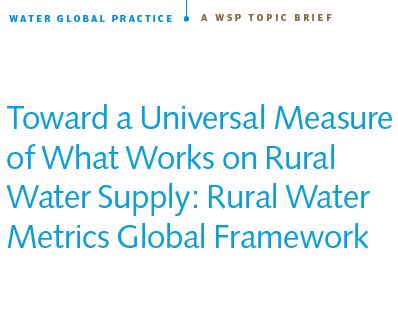Toward a Universal Measure of What Works on Rural Water Supply: Rural Water Metrics Global Framework
Problem Statement: Value of a Set of Universal Metrics Globally, the proportion of people living without improved drinking water was halved between 1990 and 2010; however, inequities remain between and within countries. For example, eight out of 10 people who are still without access to improved drinking water sources live in rural areas. Countries are now aiming for the Sustainable Development Goal (SDG) 6, which calls for universal and equitable access by 2030. This represents a far more ambitious challenge at a time when many rural water systems in developing countries are not functioning, or are performing below expected levels. Recent data suggest that although 78 percent of water point schemes are functional at one time, almost 15 percent of water points fail after one year and 25 percent of water points are non-functional by their fourth year (Banks et al. 2016). Although there is general understanding among professionals about these low levels of performance, there are few country monitoring systems that provide decision makers with sufficient and comparable evidence on numbers of systems, types of systems, and performance of systems. Given this global challenge, it might be valuable to have a standardized set of indicators that could be adopted and adapted by countries, thus facilitating improved national and global reporting and analysis. Background to the Study Countries have developed their own monitoring indicators—many of which have commonalities but are not necessarily exactly the same, and may not be similarly comprehensive. Decision makers in all countries, however, would likely benefit from ensuring that their monitoring framework produces a standard set of indicators against which to compare their rural water systems. By having one standardized global set of indicators, countries could begin to assess sustainability across aspects that are common to all situations, and in the long term to adapt their own monitoring system toward alignment for producing this set. The adoption of such global indicator set could also facilitate and contribute—along with better country monitoring systems—to the global reporting on safely managed drinking water for the Joint Monitoring Programme of UNICEF and the World Health Organization, among others. The recent SDG baseline report illustrated that only 19 countries were able to report both urban and rural data for safely managed drinking water services, underscoring the need for a better monitoring of service levels. This briefing note provides a summary of a recent World Bank study to set out such a global set of indicators. It presents the methodology and the proposed metrics which were derived from the empirical findings. It closes with a discussion on next steps and ways forward to disseminate the findings and engage with key global and national sector monitoring initiatives.
